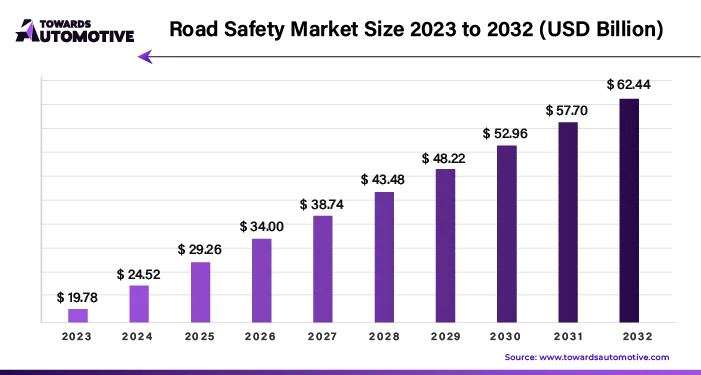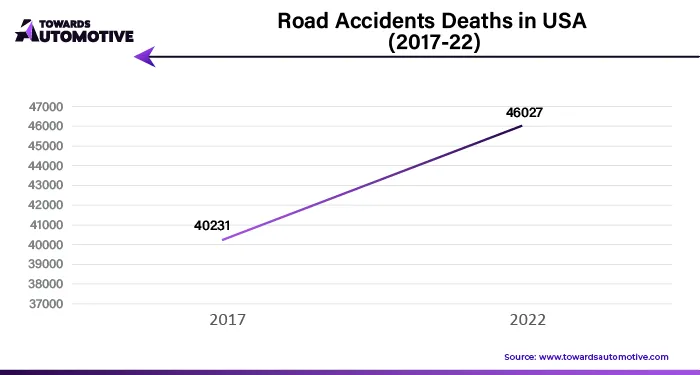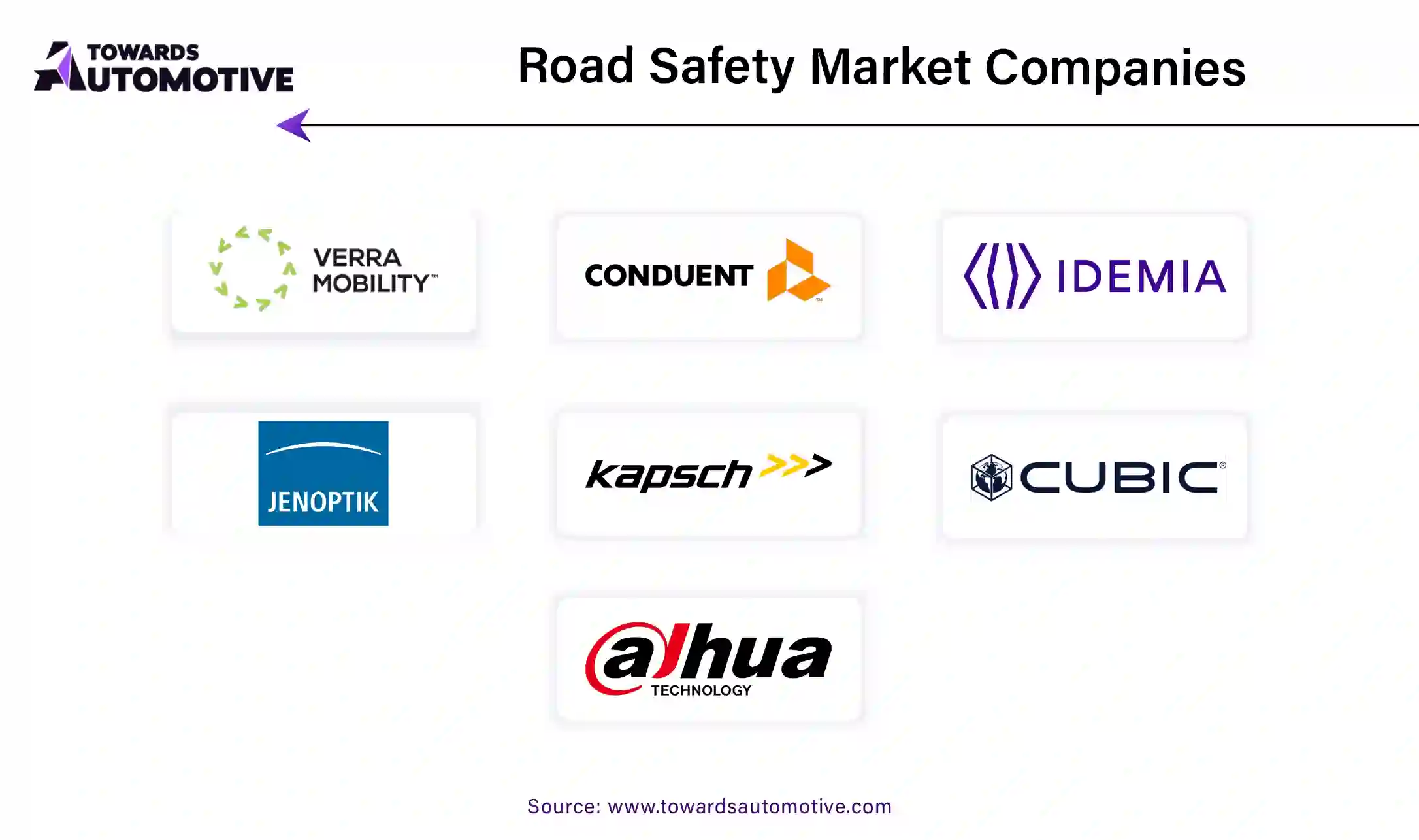April 2025
The global road safety market is forecast to grow from USD 24.34 billion in 2025 to USD 61.97 billion by 2034, driven by a CAGR of 10.94% from 2025 to 2034.
Unlock Infinite Advantages: Subscribe to Annual Membership
The road safety market plays a critical role in mitigating traffic-related risks and enhancing the safety of road users, including drivers, passengers, cyclists, and pedestrians. This dynamic market encompasses a wide range of solutions, including advanced technologies, infrastructure improvements, enforcement mechanisms, and educational initiatives aimed at reducing accidents and fatalities. Key components include intelligent traffic management systems, automated enforcement systems, pedestrian safety measures, and vehicle safety features. The growing adoption of smart technologies such as artificial intelligence (AI), machine learning (ML), and Internet of Things (IoT) devices has revolutionized road safety, enabling real-time monitoring and efficient responses to potential hazards.
Additionally, government regulations and initiatives, coupled with increased public awareness, are driving the demand for innovative safety solutions worldwide. Factors such as rapid urbanization, rising vehicle ownership, and evolving mobility trends, including the growth of electric vehicles and shared mobility, are further shaping the market landscape. Moreover, ongoing infrastructure developments, particularly in emerging economies, are creating opportunities for the deployment of advanced road safety measures. As the global population becomes increasingly mobile, ensuring road safety remains a top priority, making the road safety market a crucial element of sustainable urban development. With continuous technological advancements and collaborative efforts among stakeholders, this market is poised to address emerging challenges and achieve significant progress in safeguarding road users.
Artificial intelligence (AI) is revolutionizing the road safety market by introducing advanced solutions that enhance traffic management, accident prevention, and overall safety for road users. AI-driven technologies such as predictive analytics, computer vision, and machine learning enable real-time monitoring and analysis of road conditions, traffic patterns, and driver behavior. These technologies are instrumental in identifying potential hazards, such as erratic driving or unsafe pedestrian crossings, and providing timely alerts to prevent accidents. AI-powered traffic management systems optimize traffic flow by adjusting signals and rerouting vehicles to reduce congestion and minimize collision risks.
Autonomous vehicles, equipped with AI-based systems, further enhance road safety by eliminating human errors, which are a leading cause of accidents. Additionally, AI is integral to advanced driver assistance systems (ADAS), including lane-keeping assistance, automatic emergency braking, and adaptive cruise control, which actively support drivers in maintaining safe driving practices. In urban environments, AI-enabled surveillance systems monitor intersections and highways, ensuring compliance with traffic laws through automated enforcement. Governments and organizations are increasingly leveraging AI to analyze vast datasets for designing targeted road safety strategies. As AI continues to evolve, its integration into the road safety market holds immense potential to save lives, reduce accidents, and improve transportation efficiency globally.
The growing incidence of road accidents is a significant driver of the road safety market, as governments, organizations, and consumers increasingly recognize the need for innovative solutions to reduce fatalities and injuries. With the rising number of vehicles on the road, particularly in rapidly urbanizing regions, the frequency of traffic accidents has surged. This has placed immense pressure on public safety agencies and governments to adopt advanced road safety technologies to mitigate the risks associated with road transportation.
The increasing number of accidents, especially those caused by human errors such as distracted driving, speeding, and impaired driving, has prompted the widespread implementation of technologies like advanced driver assistance systems (ADAS), automated enforcement systems, and intelligent traffic management. These solutions aim to reduce accident rates by providing real-time alerts, improving traffic flow, and enforcing traffic rules more effectively.
Moreover, the economic and social costs associated with road accidents, including medical expenses, lost productivity, and the emotional toll on families, have made road safety a priority for governments worldwide. This drives investments in infrastructure improvements, smart traffic systems, and vehicle safety technologies. As road accidents continue to rise, both in developed and emerging markets, there is an increasing demand for automated, data-driven solutions that can help reduce collisions, improve driver behavior, and enhance pedestrian safety. Consequently, the growing cases of road accidents are expected to further fuel the expansion of the road safety market, accelerating innovation and adoption of safety technologies across regions.

The road safety market faces several restraints, including high implementation costs for advanced technologies such as intelligent traffic systems and automated enforcement tools. Budget constraints in developing regions hinder large-scale adoption, while outdated infrastructure complicates integration. Additionally, data privacy concerns and public resistance to surveillance technologies pose challenges. Lack of skilled personnel to operate and maintain advanced systems further limits growth. These factors collectively slow the widespread deployment of road safety solutions, particularly in emerging economies.
Advancements in satellite technology are creating significant opportunities in the road safety market by enabling more precise, real-time monitoring and management of traffic conditions. With the growing integration of satellite-based systems in vehicles, navigation, and traffic management, road safety measures can be enhanced in various ways. For example, Global Navigation Satellite Systems (GNSS) provide accurate location data for vehicles, improving route optimization and reducing the chances of accidents due to congestion or poorly chosen routes. These systems can help drivers avoid hazardous areas by offering real-time traffic updates, roadwork alerts, and accident notifications.
Satellite technology also plays a key role in vehicle-to-vehicle (V2V) and vehicle-to-infrastructure (V2I) communications, enabling more efficient coordination between vehicles and road infrastructure. This facilitates the development of connected vehicle ecosystems, where vehicles can communicate with traffic signals, roadside sensors, and other vehicles to exchange critical safety information. By providing precise data on vehicle location, speed, and direction, satellite technology helps in accident prevention through features such as collision detection, lane departure warnings, and automated emergency braking.
Additionally, satellite imagery is being used to monitor road conditions, identifying areas prone to accidents or requiring infrastructure improvements. By offering comprehensive situational awareness to traffic management centers, satellite technology allows for faster decision-making and more effective responses to traffic incidents. This creates opportunities for the development of more advanced, data-driven solutions to improve road safety, leading to growth in the road safety market globally.
The professional service segment held the largest share of the market. The professional services segment is a crucial driver of growth in the road safety market, offering expertise and support that ensures the effective implementation and management of safety solutions. This segment includes consulting, system integration, training, and maintenance services, which are vital for deploying and sustaining advanced road safety technologies. As governments and organizations invest in intelligent traffic management systems, automated enforcement tools, and connected infrastructure, professional services play a pivotal role in tailoring these solutions to meet specific regional and operational requirements.
Consulting services assist stakeholders in identifying vulnerabilities and designing comprehensive road safety strategies. System integration services ensure seamless connectivity between diverse technologies, such as AI-powered traffic monitoring systems, vehicle-to-infrastructure (V2I) communication networks, and automated surveillance tools. Furthermore, training programs provided by this segment equip operators and enforcement personnel with the skills needed to maximize the effectiveness of these systems.
Ongoing maintenance and support services ensure the longevity and reliability of road safety solutions, minimizing downtime and ensuring consistent performance. With the rapid adoption of advanced technologies and smart city initiatives, the demand for professional services continues to grow, as these services are indispensable in enabling a smooth transition to safer, technology-driven road environments, thereby fueling market expansion.
The red light & speed enforcement segment led the industry. The red light and speed enforcement segment is a major driver of growth in the road safety market, as it addresses two of the most common causes of road accidents: speeding and red-light violations. Automated enforcement systems, such as red-light cameras and speed detection cameras, play a pivotal role in reducing traffic violations by providing continuous monitoring and evidence-based enforcement. These systems deter reckless driving behaviors and promote compliance with traffic laws, contributing to a safer road environment for all users.
Governments and municipalities are increasingly adopting red light and speed enforcement solutions as part of broader traffic management and safety strategies. These systems reduce the need for manual enforcement, enabling authorities to allocate resources more efficiently. Advanced technologies, such as artificial intelligence (AI) and machine learning, enhance the accuracy and reliability of these enforcement tools, ensuring that violations are detected and processed with minimal errors.
The segment also benefits from growing urbanization and rising vehicle ownership, which have led to higher traffic volumes and increased risks of accidents. As cities modernize their road infrastructure, red light and speed enforcement systems are being integrated into smart traffic management networks, further driving market growth.
Europe dominated the road safety market. Rising urbanization and increased vehicle ownership, coupled with smart city initiatives and the adoption of advanced technologies, are key factors driving the growth of the road safety market in Europe. Rapid urbanization has led to denser populations in cities, resulting in more vehicles on the roads and higher risks of traffic congestion and accidents. This has created a pressing need for innovative road safety solutions, including intelligent traffic management systems and advanced driver assistance systems (ADAS), to mitigate these challenges. Additionally, Europe's proactive push toward smart city development is transforming urban mobility. Smart city initiatives integrate technologies like artificial intelligence (AI), the Internet of Things (IoT), and vehicle-to-infrastructure (V2I) communication to create safer and more efficient road networks. Smart traffic lights, automated speed enforcement systems, and real-time monitoring tools are becoming essential components of urban infrastructure. Moreover, the adoption of smart technologies in road safety enhances accident prevention and traffic flow optimization. AI-powered surveillance systems, predictive analytics, and connected vehicle technologies allow authorities to monitor road conditions and driver behavior in real time, enabling proactive interventions. Thus, the above-mentioned factors are significantly boosting the road safety market's growth in this region.
Asia Pacific is expected to grow with the highest CAGR during the forecast period. Government policies and initiatives, growing awareness of pedestrian and cyclist safety, and collaborations among stakeholders are significant drivers of the road safety market in the Asia-Pacific (APAC) region. Governments across APAC are implementing stringent road safety regulations and launching national programs aimed at reducing traffic accidents and fatalities. Initiatives such as India’s Road Safety Month and China’s Traffic Safety Campaign encourage the adoption of advanced safety technologies and promote adherence to traffic laws. These policies have increased the demand for intelligent traffic management systems, automated enforcement technologies, and improved road infrastructure.
Moreover, the rising focus on protecting vulnerable road users, including pedestrians and cyclists, is reshaping road safety strategies. Urbanization and increased mobility in cities have increased the risks for these groups, leading to the development of innovative solutions such as smart crosswalks, pedestrian detection systems, and dedicated cycling lanes.
Furthermore, collaborations between governments, private sector stakeholders, and technology providers are further accelerating market growth. These partnerships facilitate the development and deployment of cutting-edge safety solutions, such as vehicle-to-infrastructure (V2I) communication and AI-powered surveillance systems. By fostering public-private cooperation and leveraging advanced technologies, APAC is addressing critical road safety challenges, ensuring sustainable market growth along with prioritizing the safety of all road users.

By Solution
By Service
By Region
April 2025
April 2025
April 2025
April 2025
Dr. Arjun Patel is a distinguished expert in the automotive industry, holding advanced degrees in Automotive Engineering and Mechanical Engineering. His expertise spans automotive market dynamics, technological advancements, and sustainable practices. Dr. Patel excels in conducting in depth research and analysis on market trends, consumer preferences, and the economic implications within the automotive sector. He is renowned for his insightful publications on topics such as electric vehicles, autonomous driving technologies, and the evolution of sustainable transportation solutions. Dr. Patels research contributions have significantly advanced understanding in the field, earning him recognition as a leading authority in automotive research and analysis.
We offer automotive expertise for market projections and customizable research, adaptable to diverse strategic approaches.
Contact Us